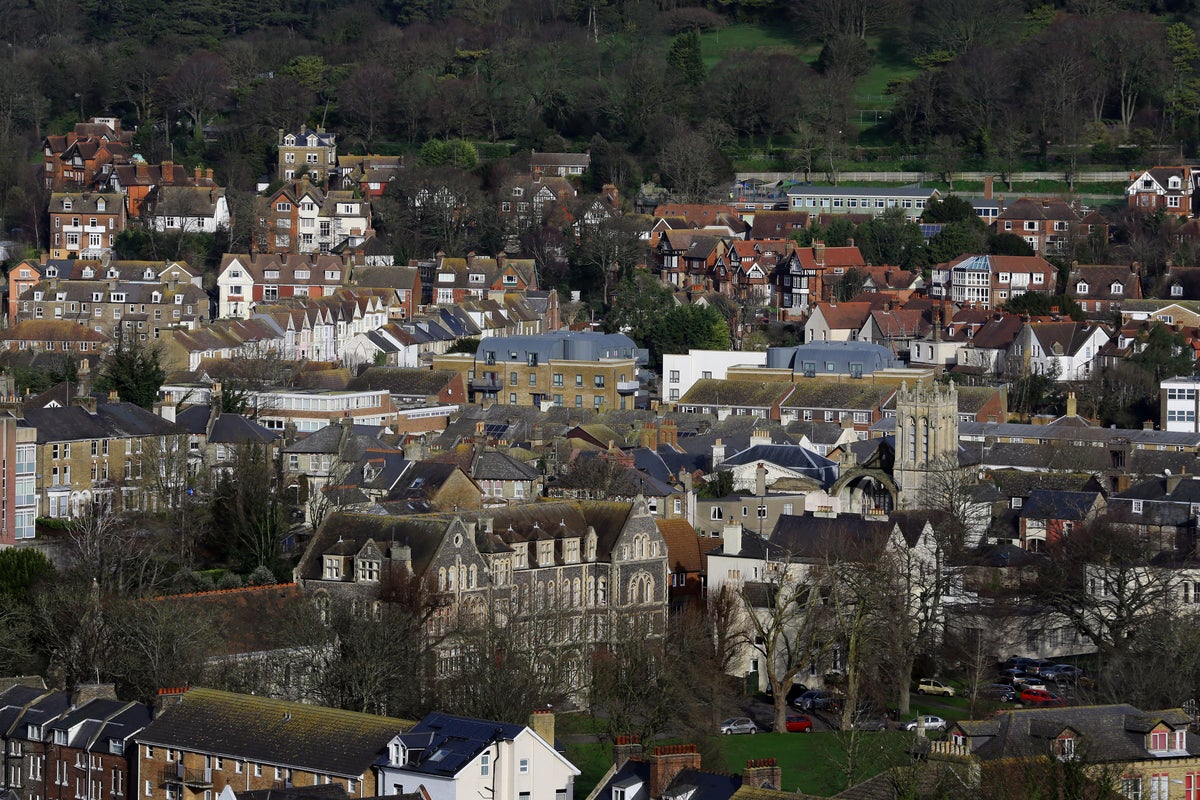
The average UK house price fell for the fourth month in a row in December, according to an index.
Property values decreased by 1.5% in December, following a 2.4% drop in November, a 0.4% decrease in October and a 0.1% dip in September, according to Halifax.
The annual rate of house price growth more than halved, to 2.0% in December, from 4.6% in November.
This marked the lowest annual growth rate recorded since October 2019, when a 1.1% increase was recorded.
Some housing market experts said that an annual fall in house prices could soon take place.
We expect there will be a reduction in both supply and demand overall, with house prices forecast to fall around 8% over the course of the year— Kim Kinnaird, Halifax Mortgages
Across the UK, the average house price in December was £281,272.
Average house prices by area across the UK and the annual increases, according to Halifax
Tthe regional annual change figures are based on the most recent three months of approved mortgage transaction data due to smaller sample sizes and so they are not directly comparable to the annual house price growth rate for the UK as a whole for the month of December:
– East Midlands, £241,850, 6.7%
– Eastern England, £337,215, 5.5%
– London, £541,239, 2.9%
– North East, £169,980, 6.5%
– North West, £226,549, 7.2%
– Northern Ireland, £183,825, 7.1%
– Scotland, £200,166, 3.5%
– South East, £395,103, 5.8%
– South West, £304,896, 6.0%
– Wales, £217,547, 6.1%
– West Midlands, £250,965, 7.3%
– Yorkshire and Humber, £205,466, 6.6%
Kim Kinnaird, director, Halifax Mortgages, said: “As we’ve seen over the past few months, uncertainties about the extent to which cost-of-living increases will impact household bills, alongside rising interest rates, is leading to an overall slowing of the market.
“The housing market was a mixed picture in 2022. We saw rapid house price growth during the first six months, followed by a plateau in the summer before prices began to fall from September, as the impact of cost-of-living pressures, coupled with a rising rates environment, began to take effect on household finances and demand.
“These trends need to be viewed in the context of historic prices. The cost of the average home remains high – greater than it was at the start of 2022 and over 11% more than house prices at the beginning of 2021.
“The first half of last year was a very strong period for sellers, between January 2022 and August 2022, the average cost of a home rose by over £17,000 to £293,992, setting a new record high.
“As we enter 2023, the housing market will continue to be impacted by the wider economic environment and, as buyers and sellers remain cautious, we expect there will be a reduction in both supply and demand overall, with house prices forecast to fall around 8% over the course of the year.
“It’s important to recognise that a drop of 8% would mean the cost of the average property returning to April 2021 prices, which still remains significantly above pre-pandemic levels.”
An annual fall in house prices appears imminent, underlining how the lending landscape has changed irrespective of the mini-budget— Tom Bill, Knight Frank
Tom Bill, head of UK residential research at estate agent Knight Frank, said: “The latest data shows two things are happening at the same time. First, the effect of the mini-budget is working its way through the system, which means that monthly declines are narrowing.
“At the same time, an annual fall in house prices appears imminent, underlining how the lending landscape has changed irrespective of the mini-budget.
“As rates normalise, buyers will increasingly recalculate their financial position and house prices will come under pressure. We expect a 10% decline over the next two years, taking them back to where they were in mid-2021.”
Alice Haine, personal finance analyst at investment platform Bestinvest, said: “While the high mortgage rates seen in October have now eased and property prices are on the decline… affordability is still a challenge for many as prices are still above pre-pandemic levels and household finances continue to grapple with the wider cost-of-living crisis.”
Mark Harris, chief executive of mortgage broker SPF Private Clients, said: “Annual house price growth continues to slow, as activity softens and the market gradually returns to something closer to what we were used to pre-pandemic.
“Mortgage rates continue to float gently downwards with a number of lenders, including Nationwide and TSB, making further reductions to fixed-rate mortgages this week.”
Iain McKenzie, chief executive officer of the Guild of Property Professionals, said: “Pessimism over the future of house prices may be misplaced. Employment figures remain strong and there are signs we may soon see falls in the wholesale fuel prices, which have helped drive up inflation and the cost of living over the past year.
“The effects of the cost-of-living crisis will continue to determine house prices in 2023 as prospective buyers take mortgage affordability into account before signing on the dotted line.”







